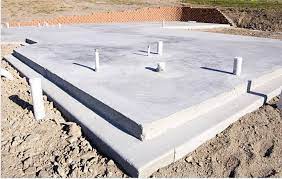Residential construction has traditionally relied heavily on concrete, which is renowned for its strength and longevity. Recently, concrete slabs have become increasingly popular for a variety of residential applications. Concrete slabs, whether employed for outdoor spaces, countertops, foundations, or flooring, present a multitude of advantages and prospects for innovative design. This blog will discuss the benefits of incorporating concrete slabs into residential construction and offer suggestions for doing so.
Residential Concrete Slabs Offer the Following Advantages:
Before we delve into design concepts, it is essential to examine the following advantages of utilizing concrete slabs in residential construction:
- Durability: Concrete is widely recognized for its high level of durability and longevity. Concrete building slabs Greenville can last for decades with proper maintenance, making them an outstanding investment for a residence.
- Strength: Concrete is highly suitable for a wide range of applications, including load-bearing walls, flooring, and foundation slabs, due to its exceptional structural support.
- Low Maintenance: Concrete demands little to no maintenance in comparison to the majority of other materials. Consistent cleaning and intermittent sealing are generally sufficient to maintain the aesthetic appeal of concrete slabs.
- Design Versatility: Concrete possesses remarkable versatility with regard to design. It is customizable with respect to color, texture, and finish to suit your aesthetic tastes.
- Energy Efficiency: When used for flooring or walls, concrete’s superior thermal mass properties help regulate indoor temperatures and reduce energy consumption.
- Sustainability: Concrete’s recyclability and adaptability make it an environmentally friendly material. Additionally, its lengthy lifespan decreases the frequency of replacements.
Ideas for Concrete Slabs in Residential Construction:
1. Slab Of Concrete Foundation:
- A concrete foundation slab furnishes a home with a solid and stable underpinning. When constructed and insulated appropriately, it has the potential to enhance energy efficiency and regulate moisture.
- Consider applying a stain or stamp to the concrete to create an aesthetically pleasing foundation that complements the exterior of your home.
2. Concrete Surfaces:
- Concrete floors are frequently found in contemporary and industrial-design dwellings. For a sleek appearance, they are resilient, simple to clean, and can be polished to a high sheen.
- Underfooting the concrete, install radiant floor heating to provide additional warmth and comfort.
3. Concrete Countertops Consist Of:
- Concrete countertops provide a distinctive and adaptable countertop material for use in kitchens and bathrooms. You may select finishes, colors, and textures to complement your interior design.
- To create an exceptional countertop, contemplate incorporating ornamental components, such as decorative aggregates or embedded glass.
4. Deck or Patio Outdoor:
- A concrete deck or patio offers a low-maintenance outdoor area suitable for socializing and leisure activities. It can be stained or stamped to mimic the appearance of natural stone or wood.
- Illustrate the atmosphere by incorporating outdoor furnishings, lighting, and landscaping elements.
5. Reinforced Concrete Walls:
- A home with interior concrete walls can have an industrial or modern ambiance. They may be painted and textured for a more refined appearance, or left unfinished for a more raw appearance.
- In addition to their long lifespan, exterior concrete walls are also amenable to a variety of aesthetic treatments, such as vertical gardens or decorative panels.
6. Stone Pathways and Walkways:
- Concrete pathways and walkways establish an aesthetically pleasing and practical link between various sections of your property.
- By staining or stamping the concrete, these pathways can be endowed with personality and elegance.
7. Fireplace Encirclements:
- Incorporating a concrete fireplace surround into your living room or outdoor space can serve as a focal point. It is adaptable to any aesthetic preference, including minimalist, rustic, or contemporary.
- Integrated shelving or storage should be contemplated for integration into the concrete surround.
8. Concrete Containers and Planters:
- Planters and containers made of concrete contribute an architectural element to a garden or indoor vegetation. They are available in a variety of sizes and shapes to accommodate your aesthetic preferences.
- The juxtaposition of the organic form of concrete with the foliage can produce a symphonious contrast.
9. Kitchen Countertops for Outdoors:
- Concrete countertops are highly recommended for outdoor kitchens and grill areas owing to their long-lasting nature and ability to withstand the adverse effects of outdoor elements.
- For added convenience, include a built-in sink, food preparation area, and storage.
10. Deck of Concrete Pools:
- A concrete pool deck improves both the safety and aesthetics of a swimming pool by providing a nonslip surface. It is customizable in terms of color and texture.
- To establish an ambiance reminiscent of a resort, incorporate lounge chairs, umbrellas, and a poolside bar.
Utilizing Concrete Slabs Suggestions:
The following are critical factors to bear in mind when integrating concrete slabs into residential construction endeavors:
- Professional Installation: For concrete slab installations, always employ seasoned professionals. Acquiring the intended outcomes necessitates meticulous preparation, curing, and finishing.
- Maintenance and Sealing: Consider applying a concrete sealant, depending on the application, to safeguard the surface and increase its durability. Maintenance and routine cleaning will aid in the preservation of its appearance.
- Insulation: Consider adding insulation to concrete foundations or flooring to increase comfort and energy efficiency.
- Customization: Concrete offers an extensive array of customization possibilities, including but not limited to embedded elements, decorative finishes, and color and texture.
- Safety: To prevent accidents, ensure that outdoor concrete surfaces, including pool decks and walkways, have non-slip finishes.
- Environmental Impact: To reduce environmental impact, select eco-friendly concrete mixes and consider incorporating recycled materials into concrete projects.
- Budget: The cost of concrete slabs can fluctuate based on customization and the degree of difficulty of the undertaking. Establish a budget and collaborate with experts to ensure that it is adhered to.
In Closing,
The numerous advantages of concrete slabs in residential construction include their low maintenance, durability, and design versatility. You can ingeniously and functionally incorporate concrete slabs into your residence by investigating a variety of design concepts and applications. Whether you decide to construct your outdoor areas, countertops, foundation, flooring, or countertops, concrete is a material that can increase the durability and aesthetic appeal of your home. Visit our website to learn more about us and how we can assist you in realizing your concrete design ideas, and explore our services.










